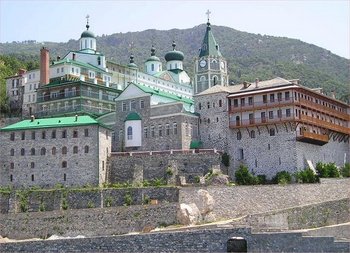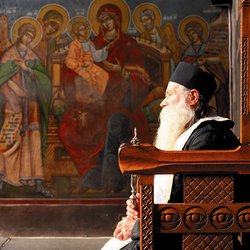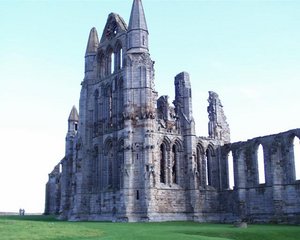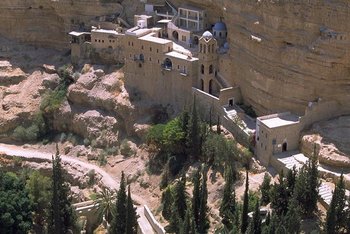Monahism
| Acest articol (sau părți din el) este propus spre traducere din limba engleză!
Dacă doriți să vă asumați acestă traducere (parțial sau integral), anunțați acest lucru pe pagina de discuții a articolului. |

| Acest articol face parte din seria Spiritualitate ortodoxă | |
| Sfintele Taine | |
| Botezul – Mirungerea Sf. Împărtășanie – Spovedania Căsătoria – Preoția Sf. Maslu | |
| Starea omului | |
| Păcatul – Patima – Virtutea Raiul – Iadul | |
| Păcate | |
| Păcate strigătoare la cer | |
| Păcate capitale | |
| Alte păcate | |
| Păcatele limbii | |
| Virtuți | |
| Virtuțile teologice | |
| Virtuțile morale Înțelepciunea – Smerenia | |
| Etapele vieții duhovnicești | |
| Despătimirea (Curățirea) Contemplația Îndumnezeirea | |
| Isihasm | |
| Trezvia – Pocăința Isihia – Discernământul Mintea | |
| Asceza | |
| Fecioria – Ascultarea Statornicia – Postul Sărăcia – Monahismul | |
| Rugăciunea | |
| Închinarea – Cinstirea Pravila de rugăciune Rugăciunea lui Iisus Sf. Moaște – Semnul Sf. Cruci | |
| Sfinții Părinți | |
| Părinții apostolici Părinții pustiei Părinții capadocieni Filocalia Scara dumnezeiescului urcuș | |
| Editați această casetă | |
Monasticism (from Greek: μοναχος—a solitary person) is the ancient Christian practice of withdrawal from the world in order to dedicate oneself fully and intensely to the life of the Gospel, seeking union with Jesus Christ.
The focus of monasticism is on theosis, the process of perfection to which every Christian is called. This ideal is expressed everywhere that the things of God are sought above all other things, as seen for example in the Philokalia, a book of monastic writings. In other words, a monk or nun is a person who has vowed to follow not only the commandments of the Church, but also the counsels (i.e., vows of poverty, chastity, stability, and obedience). The words of Jesus which are the cornerstone for this ideal are "be ye perfect as your heavenly Father is perfect."
Thus, monks practice hesychasm, the spiritual struggle of purification (καθαρσις), illumination (θεωρια) and divinization (θεωσις) in prayer, the sacraments and obedience.
Cuprins
Precursors of the Christian monastic ideal
The ancient models of the modern Christian monastic ideal are the Nazarites and the prophets of Israel. A Nazarite was a person voluntarily separated to the Lord, under a special vow.
- Speak unto the children of Israel, and say unto them, When either man or woman shall separate themselves to vow a vow of a Nazarite, to separate themselves unto the LORD: He shall separate himself from wine and strong drink, and shall drink no vinegar of wine, or vinegar of strong drink, neither shall he drink any liquor of grapes, nor eat moist grapes, or dried. All the days of his separation shall he eat nothing that is made of the vine tree, from the kernels even to the husk. All the days of the vow of his separation there shall no razor come upon his head: until the days be fulfilled, in the which he separateth himself unto the LORD, he shall be holy, and shall let the locks of the hair of his head grow. All the days that he separateth himself unto the LORD he shall come at no dead body. He shall not make himself unclean for his father, or for his mother, for his brother, or for his sister, when they die: because the consecration of his God is upon his head. (Numbers 6:2-8)
The prophets of Israel were set apart to the Lord for the sake of a message of repentance. Some of them lived under extreme conditions, voluntarily separated or forced into seclusion because of the burden of their message. Other prophets were members of communities, schools mentioned occasionally in the Scriptures but about which there is much speculation and little known. The pre-Abrahamic prophets, Enoch and Melchizedek, and especially the Jewish prophets Elijah and his disciple Elisha are important to Christian monastic tradition. The most frequently cited "role-model" for the life of a hermit separated to the Lord, in whom the Nazarite and the prophet are believed to be combined in one person, is John the Baptist. John also had disciples who stayed with him and, as may be supposed, were taught by him and lived in a manner similar to his own:
- In those days came John the Baptist, preaching in the wilderness of Judaea, And saying, Repent ye: for the kingdom of heaven is at hand. For this is he that was spoken of by the prophet Esaias, saying, The voice of one crying in the wilderness, Prepare ye the way of the Lord, make his paths straight. And the same John had his raiment of camel's hair, and a leathern girdle about his loins; and his meat was locusts and wild honey. Then went out to him Jerusalem, and all Judaea, and all the region round about Jordan, And were baptized of him in Jordan, confessing their sins. (Matthew 3:1-6)
The female role models for monasticism are the Theotokos and the four virgin daughters of the Apostle Philip (of the Twelve):
- And when we had finished our course from Tyre, we came to Ptolemais, and saluted the brethren, and abode with them one day. And the next day we that were of Paul's company departed, and came unto Caesarea: and we entered into the house of Philip the evangelist, which was one of the seven; and abode with him. And the same man had four daughters, virgins, which did prophesy. (Acts 21:7-9)

The monastic ideal is also modeled upon the Apostle Paul, who is believed to have been celibate, and a tentmaker:
- For I would that all men were even as I myself. But every man hath his proper gift of God, one after this manner, and another after that. I say therefore to the unmarried and widows, it is good for them if they abide even as I. (I Corinthians 7:7-8)
But the consummate prototype of all Christian monasticism, communal and solitary, is Jesus Christ:
- Let this mind be in you, which was also in Christ Jesus: Who, being in the form of God, thought it not robbery to be equal with God: But made himself of no reputation, and took upon him the form of a servant, and was made in the likeness of men: And being found in fashion as a man, he humbled himself, and became obedient unto death, even the death of the cross. (Philippians 2:5-8)
Additionally, the earliest Church was a model for monasticism. The first Christian communities lived in common, sharing everything, according to Acts of the Apostles.
Origins of Christian monasticism
The institution of Christian monasticism began in the deserts in 4th century Egypt as a kind of living martyrdom. Some scholars attribute the rise of monasticism at this time to the changes in Roman society that had been brought about subsequent to the Emperor St. Constantine's conversion and the legal tolerance of Christianity in the Roman Empire. This ended the position of Christians as a small, persecuted group, leading to the rise of nominal Christianity within the Church. In response, many who wished to maintain the intensity of the earliest years of Christian life fled to the desert to fast and pray, free from the fragmenting influence of the world. The end of persecution also meant that martyrdom was no longer as common, and so asceticism as a form of living martyrdom came to be pursued.

Ss. Anthony and Pachomius were early monastic founders in Egypt, although Paul of Thebes is the very first Christian historically known to have been living as a monk. Orthodoxy also looks to Basil the Great as a founding monastic legislator, as well as the example of the Desert Fathers. St. Benedict of Nursia, who based his own Rule on that of St. Basil, is often credited with being the father of Western monasticism.
From a very early time there were probably individuals who lived a life in isolation—hermits—in imitation of Jesus' 40 days in the desert. They have left no confirmed archaeological traces and only hints in the written record. St. Anthony of Egypt lived as a hermit and developed a following of other hermits who lived nearby but not in community with him. On the other hand, Paul of Thebes lived not very far from Anthony in absolute solitude, and was looked upon even by Anthony as a perfect monk. (When St. Anthony first encountered him, he came away from the experience saying, "Woe is me, my children, a sinful and false monk, who am a monk in name only. I have seen Elijah, I have seen John the Baptist in the desert, and I have seen Paul—in Paradise!") This variety of monasticism is called eremitic ("hermit-like").
St. Pachomius the Great, a follower of Anthony, also acquired a following; he chose to mould them into a community in which the monks lived in individual huts or rooms—cells (from Greek κελλια)—but worked, ate, and worshipped in shared space. This method of monastic organization is called cenobitic ("community-based"). Most monastic life is cenobitic in nature. The head of a monastery came to be known by the word for "Father" in Syriac, Abba—in English, Abbot.
Eventually, a pattern came to be established for some rare monks, having been formed in the communal life, to leave the cenobitic context and undertake the eremetic life. To attempt it without this prior formation is often considered to be spiritual suicide, frequently leading one to fall into prelest, spiritual delusion.
The place of monasticism in society
Beginning in Egypt (with such saints as Anthony the Great and Paul of Thebes) and spreading to the Middle East and then Europe, monasticism became a central aspect of life during the western Middle Ages and the high period of the Roman ("Byzantine") Empire in the East. The first non-Roman area to adopt the system was Ireland, which developed a unique form closely linked to traditional clan relations, a system that later spread to other parts of Europe, especially France.
The golden age of Christian monasticism lasted from about the eighth to the twelfth centuries. The monasteries became an essential part of society, often acting to unify liturgical practice and clarify doctrinal disputes. The monasteries also attracted many of the best people in society and during this period the monasteries were the central storehouses and producers of knowledge.

In the West, the system broke down in the eleventh and twelfth centuries as religion began to change. Religion became far less a preserve of the religious elite. This was closely linked to the rise of mendicant orders such as the Franciscan friars, who were dedicated to spreading the word in public, not in closed monasteries. Religious behavior changed as common people began to take communion and actively participate in religion. The growing pressure of the nation states and monarchies also threatened the wealth and power of the orders. Finally, after Vatican II in Rome, "religious" orders saw a massive exodus of members, and many monastics left off wearing the traditional garb of their orders. On the whole, monasticism is in severe decline in the Roman Catholic Church. Nevertheless, monasticism is still reflected strongly in western culture. Modern universities have attempted to ape Christian monasticism in a number of ways. Even in the New World where monasticism has never been a standard part of societal life, universities are built in the Gothic style of twelfth century monasteries. Communal meals, dormitory residences, elaborate rituals and dress all borrow heavily from the monastic tradition.
In the East, monasticism continued to thrive even after the Great Schism of the eleventh century, becoming a touchstone and unifying center for Christians in the declining Roman Empire, even after the Fall of Constantinople.
Orthodox monasticism today

Today monasticism remains an important and vital part of the Orthodox Christian faith, and major monastic centers such as Mount Athos and St. Catherine's Monastery (Sinai) are seeing a revival both in terms of the numbers of monks coming to take up the life and in terms of the intensity of the life being led. Pilgrims are also becoming more and more frequent, and rebuilding of many ancient centers of monasticism is moving forward at a high rate.
Monastic clergy
Christian monasticism is in itself a lay order, originally not having clergy as a standard part of the community (thus, monks relied on local parishes for sacramental life). However, if the monastery were isolated in the desert, as were many of the Egyptian communities, that inconvenience compelled monasteries either to take in priest members, to have their abbot ordained, or to have other members ordained. A priest-monk is called a hieromonk, and is now generally considered a standard part of cenobitic monastic life. Monastic deacons are also fairly common, and they are referred to as hierodeacons.
In many cases in Orthodoxy, when a bishopric needs to be filled, suitable candidates are found from nearby monasteries. Since many priests are married (before being ordained to the priesthood), but bishops are required to be celibate, monasteries are a good source of celibate men who are also spiritually mature and generally possessing the other qualities desired in a bishop. Numerous saints from the Church's tradition are examples of this practice.
See also

External links
- Monasticism in the Orthodox Church by Metropolitan Maximos (Aghiorgoussis) of Pittsburgh
- Orthodox Monasticism (Serbian Orthodox Diocese of Raska and Prizren)
- The Ascetic Ideal and the New Testament by Fr. Georges Florovsky
- Orthodox Monasteries Worldwide Directory
